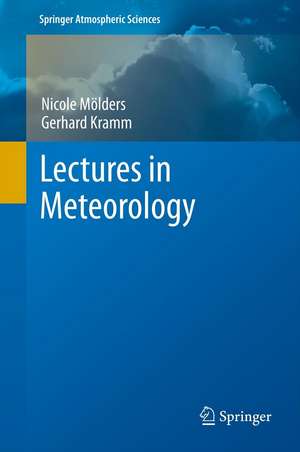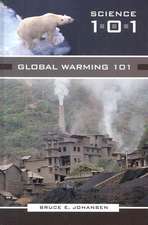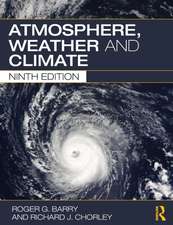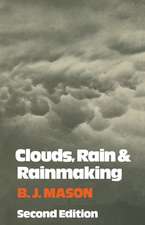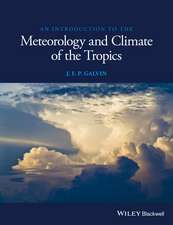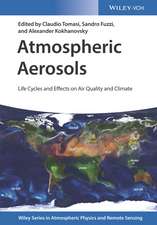Lectures in Meteorology: Springer Atmospheric Sciences
Autor Nicole Mölders, Gerhard Krammen Limba Engleză Hardback – 20 aug 2014
| Toate formatele și edițiile | Preț | Express |
|---|---|---|
| Paperback (1) | 741.54 lei 6-8 săpt. | |
| Springer International Publishing – 22 sep 2016 | 741.54 lei 6-8 săpt. | |
| Hardback (1) | 747.83 lei 6-8 săpt. | |
| Springer International Publishing – 20 aug 2014 | 747.83 lei 6-8 săpt. |
Din seria Springer Atmospheric Sciences
- 24%
 Preț: 814.28 lei
Preț: 814.28 lei - 18%
 Preț: 891.33 lei
Preț: 891.33 lei - 15%
 Preț: 649.39 lei
Preț: 649.39 lei - 18%
 Preț: 956.81 lei
Preț: 956.81 lei - 18%
 Preț: 1133.13 lei
Preț: 1133.13 lei - 23%
 Preț: 732.57 lei
Preț: 732.57 lei - 23%
 Preț: 679.88 lei
Preț: 679.88 lei - 18%
 Preț: 732.07 lei
Preț: 732.07 lei - 20%
 Preț: 765.26 lei
Preț: 765.26 lei - 24%
 Preț: 804.86 lei
Preț: 804.86 lei - 15%
 Preț: 637.28 lei
Preț: 637.28 lei - 24%
 Preț: 1594.80 lei
Preț: 1594.80 lei - 18%
 Preț: 966.27 lei
Preț: 966.27 lei -
 Preț: 429.66 lei
Preț: 429.66 lei - 15%
 Preț: 468.90 lei
Preț: 468.90 lei - 18%
 Preț: 784.79 lei
Preț: 784.79 lei - 18%
 Preț: 956.03 lei
Preț: 956.03 lei - 24%
 Preț: 826.77 lei
Preț: 826.77 lei - 18%
 Preț: 1398.31 lei
Preț: 1398.31 lei - 18%
 Preț: 1692.84 lei
Preț: 1692.84 lei - 18%
 Preț: 1006.72 lei
Preț: 1006.72 lei - 15%
 Preț: 643.34 lei
Preț: 643.34 lei - 24%
 Preț: 831.83 lei
Preț: 831.83 lei - 15%
 Preț: 534.50 lei
Preț: 534.50 lei - 18%
 Preț: 1229.40 lei
Preț: 1229.40 lei - 15%
 Preț: 639.90 lei
Preț: 639.90 lei - 24%
 Preț: 816.10 lei
Preț: 816.10 lei - 24%
 Preț: 1564.06 lei
Preț: 1564.06 lei - 15%
 Preț: 638.57 lei
Preț: 638.57 lei
Preț: 747.83 lei
Preț vechi: 911.99 lei
-18% Nou
Puncte Express: 1122
Preț estimativ în valută:
143.09€ • 149.81$ • 118.40£
143.09€ • 149.81$ • 118.40£
Carte tipărită la comandă
Livrare economică 05-19 aprilie
Preluare comenzi: 021 569.72.76
Specificații
ISBN-13: 9783319021430
ISBN-10: 3319021435
Pagini: 456
Ilustrații: XIX, 591 p. 201 illus., 17 illus. in color.
Dimensiuni: 155 x 235 x 30 mm
Greutate: 1.03 kg
Ediția:2014
Editura: Springer International Publishing
Colecția Springer
Seria Springer Atmospheric Sciences
Locul publicării:Cham, Switzerland
ISBN-10: 3319021435
Pagini: 456
Ilustrații: XIX, 591 p. 201 illus., 17 illus. in color.
Dimensiuni: 155 x 235 x 30 mm
Greutate: 1.03 kg
Ediția:2014
Editura: Springer International Publishing
Colecția Springer
Seria Springer Atmospheric Sciences
Locul publicării:Cham, Switzerland
Public țintă
GraduateCuprins
Introduction.- Thermodynamics.- Clouds and Precipitation.- Atmospheric Radiation.- Atmospheric Chemistry.- Dynamics and Synoptic.- Climate and Climatology.
Recenzii
“‘Lectures in Meteorology’ is a comprehensive bookon meteorology that provides concise lectures on many topics ranging fromatmospheric physics, atmospheric chemistry and atmospheric dynamics to climate.… best serve as a quick reference book for atmospheric scientists and graduatestudents studying atmospheric science or to the point study guide forscientists of different expertise interested in learning meteorology forresearch applications. It is undeniably a strong reference book that will be agreat addition to any library.” (Muge Komurcu, Pure and Applied Geophysics,Vol. 172, 2015)
Notă biografică
Nicole Mölders earned her PhD at the University of Cologne in 1992 and her habilitation at the University of Leipzig in 1999. She uses mesoscale and climate models to investigate human and natural impacts on weather, air quality and climate with special focus on the Arctic. From 1999-2001, she was honored as a Heisenberg Fellow for Physical Hydrology, a prestigious award conferred by the DFG (German Research Foundation). After her time at NCAR (National Center for Atmospheric Research), she joined the University of Alaska Fairbanks (UAF). She has taught meteorology including cloud physics and satellite meteorology, numerical modeling and parameterization methods, mesoscale dynamics, and introduction to computational meteorology. She is Editor-in-Chief of Climate and on the advisory board for Springer Briefs in Climatic Studies.
Gerhard Kramm earned his PhD in meteorology at the Humboldt University of Berlin in 1994. At UAF, his research activities are mainly focused on the theoretical aspects of meteorology, in particular, micro-meteorology (including turbulence and its impact upon chemical processes), dynamics, radiation, and climate change. Since 2005, he has served on the editorial board of the Journal of the Calcutta Mathematical Society. He has taught atmospheric dynamics, atmospheric radiation, physics of the atmospheric boundary layer, and turbulence. In 2007, he was the lead instructor of the Science Teacher Education Program on Global Climate Change. He joined the Editorial Board of the Datasets Papers in Geosciences (Atmospheric Sciences) in 2012.
Gerhard Kramm earned his PhD in meteorology at the Humboldt University of Berlin in 1994. At UAF, his research activities are mainly focused on the theoretical aspects of meteorology, in particular, micro-meteorology (including turbulence and its impact upon chemical processes), dynamics, radiation, and climate change. Since 2005, he has served on the editorial board of the Journal of the Calcutta Mathematical Society. He has taught atmospheric dynamics, atmospheric radiation, physics of the atmospheric boundary layer, and turbulence. In 2007, he was the lead instructor of the Science Teacher Education Program on Global Climate Change. He joined the Editorial Board of the Datasets Papers in Geosciences (Atmospheric Sciences) in 2012.
Textul de pe ultima copertă
Lectures in Meteorology is a comprehensive reference book for meteorologists and environmental scientists to look up material on the thermodynamics, dynamics and chemistry of the troposphere. The lectures demonstrate how to derive/develop equations – an essential tool for model development. All chapters present applications of the material including numerical models. The lectures are written in modular form, i.e. they can be used at the undergraduate level for classes covered by the chapters or at the graduate level as a comprehensive, intensive course. The student/instructor can address chapters 2 (thermodynamics) and 4 (radiation) in any order. They can also switch the order of chapter 5 (chemistry) and 6 (dynamics). Chapter 7 (climatology and climate) requires an understanding of all chapters. Chapter 3 (cloud physics) needs basics from chapter 2 to understand the cloud microphysical processes. The governing conservation equations for trace constituents, dry air, water substances, total mass, energy, entropy and momentum are presented, including simplifications and their application in models. A brief introduction to atmospheric boundary layer processes is presented as well. Basic principles of climatology discussed include analysis methods, atmospheric waves and their analytical solutions, tropical and extra-tropical cyclones, classical and non-classical mesoscale circulations, and the global circulation. The atmospheric chemistry section encompasses photolytic and gas-phase processes, aqueous chemistry, aerosol processes, fundamentals of biogeochemical cycles and the ozone layer. Solar and terrestrial radiation; major absorber; radiation balance; radiative equilibrium; radiative-convective equilibrium; and basics of molecular, aerosol and cloud adsorption and scattering and their use in remote sensing are also presented.
Caracteristici
The lectures are written in module form The book can be used for in-depth study but also for quick reference, as well as repetition of material The lectures can be used at the undergraduate level for the separate classes covered by the chapters or at the graduate level as a one semester comprehensive, intensive course
